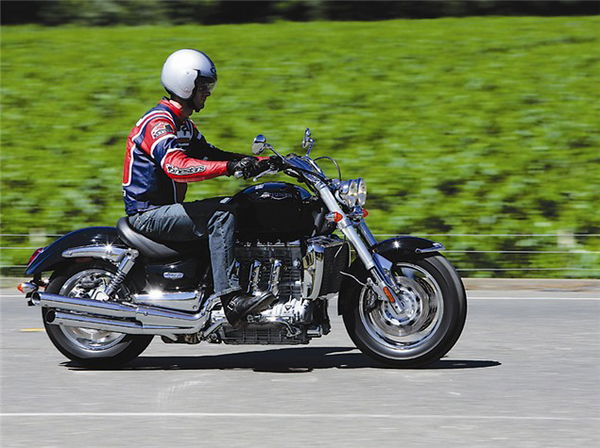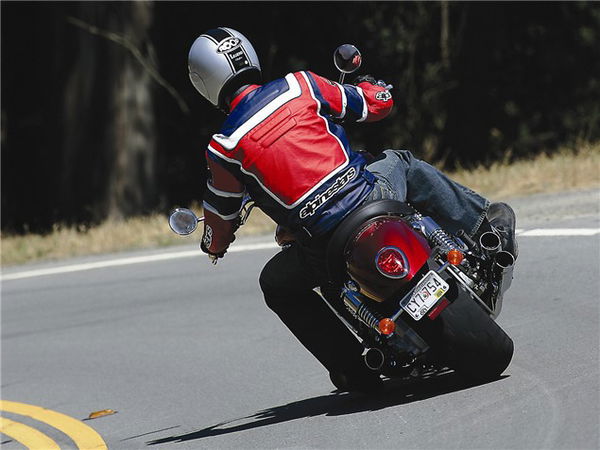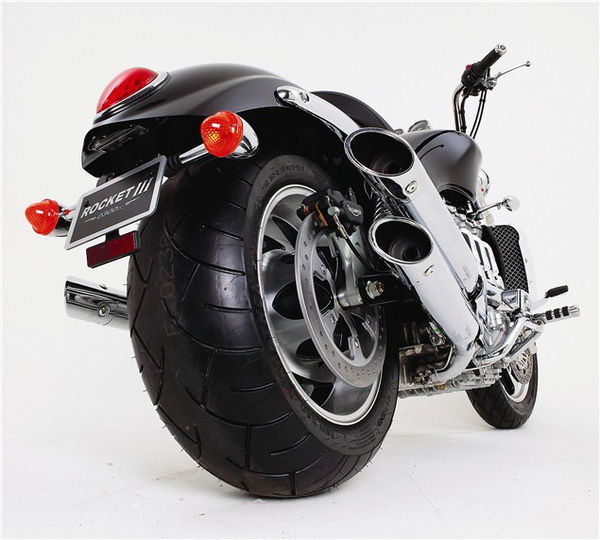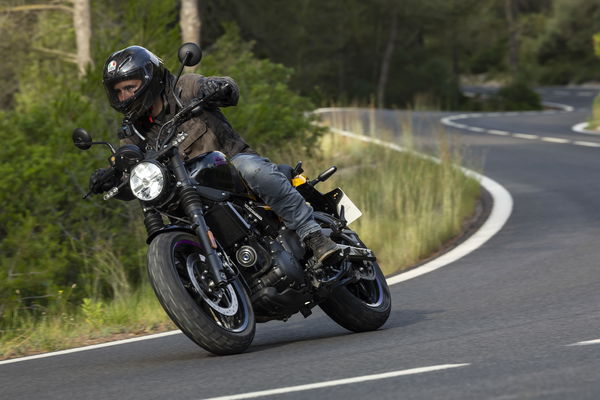Rocket III (2004) review
The 2004 Rocket III has an engine larger than most family estates, so naturally Triumph launched this flagship model in the land where excess is the name of the game.


2004 Rocket III: Design
California Dreamin' on Highway 1, the cool sea breeze tickling your skin as you click the giant 2.3litre Triumph into third, indicate left, crack the throttle to feel the torque explosion and blast past another American tourist on this famous coastal stretch.
The first thing that is evident as you walk around the Triumph Rocket III is that this is one big bike. From its glaring bug-eyed twin headlights to the huge snarling radiator, it looks ready for anything and woe betide any who get in the way.
Swinging a leg over and slumping into the plush seat, the thought behind rider and bike ergonomics was instantly apparent. The riding position is excellent. The foot controls are slung forward and the wide bars pull back nicely to offer supreme control. Ride 10 or 500 miles in one day and the wide plush gel-packed seat will remain 100% comfy.
Triumph consulted test groups in the USA, the main market for the Rocket III, at early stages of development to ensure that all styling characteristics were met. To ape Harley would have been so easy, but just looking at the Rocket, I feel that it has found its own true styling niche. The Rocket is a fantastic mix of classic lines, bulk and sleek sophistication. There's enough chrome to keep you busy polishing for hours on a rainy Sunday afternoon! Triumph has even thought about solo riding, with an easily removable pillion pad.
The fuel tank is an integral part of the design package, with your legs slipping into the recesses making it easy to hug the tank.
With a whopping 26-litre capacity, it has an average fuel range of 180 miles before the light comes on. If you ride flat stick everywhere, then this figure will drop below the healthy 42mpg, but riding as Mother Cruiser intended at 55-70mph will produce excellent fuel economy and a range that most tourers would envy. Then there are still four litres left on reserve...
The bars spread you wide like a sail making hard acceleration and consistent 100mph-plus speed a royal pain in the neck. And shoulders. And legs - and arms! Drop the revs back and cruise at 55mph and the Rocket III is almost perfection personified.

2004 Rocket III: Engine
The engine has a beautiful mid-range that feels happy at such a sedate pace, yet unlike a sportsbike doesn't feel as if it is hassling you like a naughty imp to hit illegal speeds. Unless you want to!
The official figures are not to be baulked at. 147lb.ft of torque at 2500rpm, 140bhp at the giant 17kg crank at 5750rpm and a genuine 115bhp (est) feeding through to the rear wheel.
Even with a total weight of 320kg, most of today's modern sports bikes will be green with envy at these power statistics. You'd think that a motorcycle displaying these dimensions would want to stick to long straight roads.
Well, the Rocket doesn't. Like a playful dog running along at your heels in the park, it waits expectantly for you to throw a ball or stick for it to get into its stride. The Rocket munches anything in its path.
With a genuine 120mph on the straights, she then has more than enough ground clearance (eight inches), to comfortably sweep through the twistiest of routes. This is made simpler due to the low centre of gravity that makes it a doddle to throw her from side to side. The only time she can buck under you is over the more potholed roads; otherwise she just laughs, shrugs her shoulders and gets on with enjoying the ride ahead.
I can't believe how much torque is on tap from such low revs. Even in top gear burbling at just under 2000rpm, the engine doesn't falter, or miss a beat. Instead, the fuel injection is crisp and the throttle just begs to be cracked wide open for that adrenalin rush, launching you forward in a controlled but explosive manner.
The power delivery can be very deceptive, however. Top gear roll-ons from 60-100mph feel almost sluggish at first. Try the same move again and glance briefly at the speedometer and you realise just how quickly that needle rises! No data equipment was at hand but a mental count - thousand and one thousand and two thousand and three thousand and four thousand and - 100mph. She had a ton up in just over four seconds!
The engine was always destined to be the focal point of the Rocket III - at 2.3litres, how could it not be? The three chromed header pipes all exit on the right, due to the position of the engine, but act as a visual cache. The engine also serves as an integral part of the chassis, bolting directly to the tubular steel frame and swingarm. Acting almost as a cross brace to the rest of the chassis, the engine strengthens the headstock for improved feel and stiffness of the front end.
A first for Triumph - and the world - is that the Rocket III engine is three years ahead in terms of emissions. It's the first engine to have passed the stringent Cat 3 European Emissions laws due to hit manufacturers hard in 2007.
Basically, there are two catalytic converters in the exhaust collector box. They've been placed as near to the headers as possible, so that more gasses are burnt at an earlier stage, making the Triumph a greener proposition.
Fuel injection was always going to be a certainty on the Rocket. Why? With huge 52mm throttle bodies, twin butterfly valves were needed and the easiest and most efficient way to control them was by ECU. Triumph has been able to produce a particularly smooth power delivery by doing so.
By dropping the power seven per cent in first and second gears and leaving third as a transitional gear, full power can be delivered in fourth and fifth in a safe environment, when on the open road, rather than filtering through busy traffic. Throttle response is almost instantaneous. Not surprisingly, the Rocket III produces more torque at idle than a Triumph Tiger's maximum power output.
Shaft final drive is used by Triumph for the first time and this could be why the five-speed gearbox is the only potential downside to the Rocket III. Mostly slick, it did get lumpy after a while, with first often difficult to find at the lights.
As a bonus, the shaft is completely maintenance free. The clutch is light and letting it slip out from a standstill, it's possible to hoist the front or spin up the rear, showing just how much power is initially available. Triumph has already made an aftermarket rocker gear change assembly and I think this would make an invaluable addition to both the styling and the ease of gear changes.
The standard exhaust note is disappointingly quiet, allowing you to move in on prey like a stealth bomber, unnoticed until the final strike. However, whack on the straight-through aftermarket pipes - minus the Cat converters - and she roars to life with all the finesse of a herd of wildebeest. Click down through the gears coming into town and she spits and farts like a cowboy. That glorious exhaust note of a Triumph triple with open pipes announces your arrival to all and sundry five minutes before anyone sees the front wheel!

2004 Rocket III: Brakes
The brakes are superb. To the front are giant 320mm twin discs with four pot calipers, taken directly from the 955i, which bring all of the 320kg to an almost instant standstill. I don't think that I fretted once that she wouldn't haul up with plenty of breathing space. Even braking down hard from a ton, she still had plenty of feel and bite to leave you concentrating on the road ahead, rather than preparing for Flintstone-style feet down braking.
The 316mm twin pot rear is equally solid and has been designed specifically by Brembo for the Rocket III. You sometimes forget in a world of sportsbikes that the back brake even exists. You almost learn to ride the brakes back to front when riding something this large, relying more on the rear.
2004 Rocket III: Handling
The handling is phenomenal. With the engine set low in the frame thanks to the dry sump, the centre of gravity is so low it makes the Rocket supremely easy to manoeuvre at any speed and for any sized rider. Take your hands off the bars at 70mph and she doesn't waver, filling you with confidence in the bike's balance. Instead, she remains perfectly focused like an obedient pedigree at Crufts!
The 240 section rear may be for show - and could go down a few sizes - but it doesn't affect the handling, except to accentuate the solid feel of stability. The price may make you think twice about performing endless burnouts, as it's around the £300 mark for the pair!
Now, what does any discerning cruiser rider want to do once the bike is run in? Personalise and add as many aftermarket parts as humanly possible to an already gleaming steed. There will be 51 products by the time the Rocket III hits the dealers, with more to follow later in the year. These will range from touring screens to body paint kits, exhausts and digital oil pressure gauges. Oh, and more chrome than you could possibly shake a stick at! Total cost for the lot? Around £4000, which by comparison with a certain American rival is real value for money.
Triumph's marketing has obviously worked, with deposits taken for every model coming to the UK and then some. Where are these deposits coming from? Well, 25% sportsbikes owners, 25% Triumph owners (obviously) - and 25% Harley owners. The last one is a big coup. Triumph owners are renowned for brand loyalty, but to get that percentage away from Harley riders is exceptional. All without a test ride!

2004 Rocket III: Suspension
The Rocket III is the first Triumph to use a shaft final drive, both to maintain an identity away from Harley-Davidson, and to prove almost maintenance-free to the consumer. Belt or chain drive was not really an option, given the massive torque produced by the 2.3litre engine.
Front suspension is 43mm inverted forks developed by Japanese suspension specialists Kayaba, and similar to those fitted to most current sportsbikes. Again, the use of USD forks is a first for Triumph.
Linked with the tubular steel frame and double-sided steel swingarm, they improve front end stiffness and rear traction, enabling the Rocket III to handle as a true sports cruiser.
Twin chromed rear shock springs have adjustable preload, and have been kept for the purists rather than using the more common hidden monoshock favoured by Harley and the Japanese.
Should I buy the 2004 Rocket III?
Triumph has definitely produced the surprise of 2004 and the new benchmark. The Rocket handles, cruises and flies like the proverbial off a shovel! Owners won't be disappointed and Triumph will need to look at increasing production over the coming months. Next time you get blasted on the quarter mile from the lights, it may well be the big beast from Hinckley.
2004 Rocket III: Specs
- TYPE - CRUISER
- PRODUCTION DATE - 2004
- PRICE NEW - £11,990
- ENGINE CAPACITY - 2294cc
- POWER - 140bhp@5750rpm
- TORQUE - 147lb.ft@2500rpm
- WEIGHT - 320kg
- SEAT HEIGHT - N/A
- FUEL CAPACITY - 24L
- TOP SPEED - 140mph
- 0-60 - n/a
- TANK RANGE - N/A










